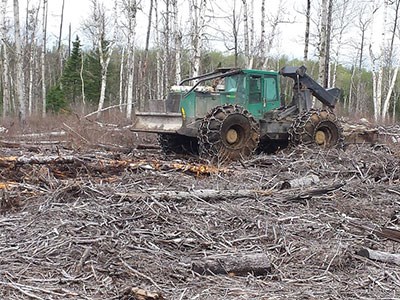Almost five years into his tenure as chairman of Nawiinginokiima Forest Management Corporation (NFMC), Daryl Skworchinski still maintains it’s the right concept to manage the flow of Crown fibre on the North Shore of Lake Superior.
Skworchinski, who also serves as CAO for the Town of Marathon, estimates the economic impact to the participating communities and First Nations is likely in the “multi-millions of dollars.”
The payroll of the corporation’s management team of foresters and silviculturists accounts for close to $1 million, and it’s had a positive impact on area businesses and trucking companies hauling wood to area mills.
After years of provincial and local planning, Nawiinginokiima was activated by the province in the spring of 2011 as the first pilot project established under the province’s overhauled forest tenure strategy.
The intent was to deliver local control through a community-based agency by giving them the power for negotiating, marketing and overseeing the sale of wood on four Crown forest management units.
First Nation communities like Pic Mobert have established their own harvesting company to supply the White River sawmill, of which the community has partial ownership.
Now Pic River First Nation is getting into the forestry business as the band has invested $2.5 million in purchasing harvesting equipment to supply fibre to area mills.
Pic River has ordered harvesting equipment from Finland that is due for delivery sometime this winter to be ready for operation by next spring.
The NFMC has provided $1 million to the Pic River Development Corporation to help them ramp up that capacity to move fibre to pulp and sawmills in the area.
“The way the agreement is structured is based on milestones,” said Skworchinski. “As they reach milestones in the harvesting operation, we will release more cash to them.”
Officials with Pic River First Nation were not available for comment.
The new forestry venture stands to create between six and eight jobs.
Besides harvesting, the First Nation will be contracted with the corporation to provide care and maintenance of the Caramat Road, a vital logging road.
Prior to the closure of Marathon Pulp in 2009, Pic River had previously been a fibre supplier to the mill.
“Their big focus was on construction of the power dam on the White River, now they’re getting back into an operation they were traditionally involved in,” he said.
Most of the available spruce, pine and fir in the four management units are earmarked for area mills like White River Forest Products and AV Terrace Bay. What’s left over – roughly 10 per cent – is of limited commercial use.
“We’re working with the ministry looking at what’s the most efficient and valuable way to put that wood on the open market,” he said.
Marathon has dabbled with private sector proposals to manufacture and ship wood pellets to Europe.
“We certainly have visions of facilitating that in Marathon. We’re in the final eight to 12 months of the demolition of our mill, at which time we’ll have a heavy industrial site that’s available for development.”
On the forestry side, Skworchinski said, the management corporation has been productive.
On the regulatory end, the corporation still doesn’t have formal control over the management units.
The Ministry of Natural Resources and Forestry has given the corporation the date of next April 1 when the transfer of the Sustainable Forest Licence documents will occur.
“It’s always a challenge in working with the province with respect to a new venture,” said Skworchinski.
Despite all the regulatory challenges, he believes it’s still the right model for many areas of the province.
“There’s no question it’s working on our particular area, especially as we enter into these agreements with Pic River and Pic Mobert, and we expand the corporation in terms of the our tree plants. It’s starting to reach the vision that the board had when we were first established in terms of that five-year vision.”




